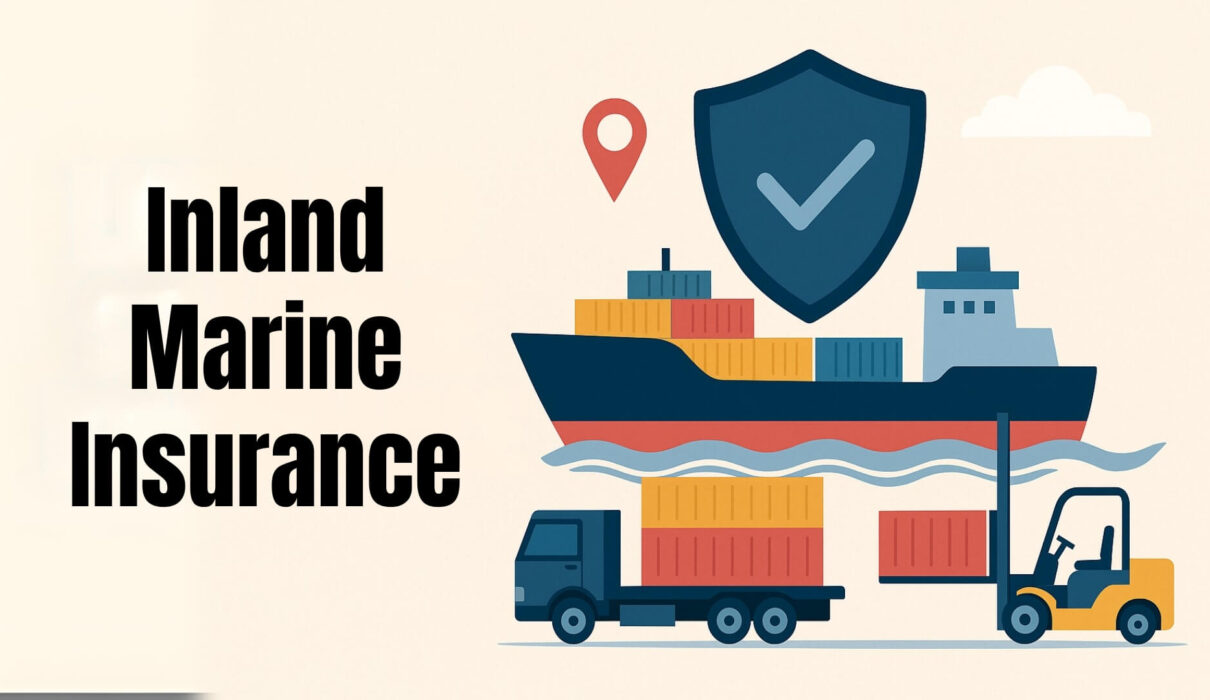If you’re a business owner in Canada moving equipment, goods, or materials across provinces, you might have come across the term inland marine insurance. It’s not about boats on lakes—it’s a vital coverage for assets on the move or stored temporarily. With over a decade of experience as a Canadian insurance advisor, I’ve helped countless businesses avoid financial pitfalls with this policy. In this expanded 1500-word guide, I’ll unpack what inland marine insurance is, who needs it, what it covers, and how to make it work for your operation. Whether you’re a contractor in Alberta, a manufacturer in Ontario, or a logistics firm in British Columbia, this blog will give you the tools to protect your assets effectively. Let’s get started.
What Is Inland Marine Insurance?
The name inland marine insurance can be misleading—it doesn’t cover water-based transport like ocean marine insurance. Its roots trace back to the 19th century when goods moved beyond ports, requiring protection over land. Today, it’s a specialized form of property insurance designed for movable assets, whether in transit or at temporary locations. In Canada, this means covering everything from construction tools hauled to a job site in Saskatchewan to high-value inventory shipped from Montreal to Vancouver.
Unlike standard property insurance, which protects fixed assets at a single location, inland marine insurance steps in for items on the go. Imagine a logging company’s $100,000 worth of chainsaws damaged during a winter haul through the Rockies—standard coverage might not apply, but inland marine insurance could. This flexibility makes it a cornerstone for businesses operating across Canada’s vast landscape, where long distances and harsh weather amplify risks.
Who Needs Inland Marine Insurance in Canada?
Not every business requires inland marine insurance, but certain industries in Canada can’t operate without it. Here’s a detailed look at who benefits:
- Construction Companies: If you’re transporting bulldozers, cranes, or scaffolding across provinces, a breakdown, theft, or accident can derail projects. A colleague in Ottawa once faced a $50,000 loss when vandals hit a stored excavator—insurance covered 80% of the cost.
- Manufacturers: Companies shipping raw materials or finished goods, like a Quebec furniture maker sending tables to retail stores, need protection against transit damage. I worked with one client who avoided a $20,000 loss after a truck rollover.
- Logistics and Trucking Firms: With goods moving from coast to coast—say, electronics from Vancouver to Halifax—risks like collisions or cargo theft are common. This coverage ensures you’re not left footing the bill.
- Retailers with Mobile Inventory: Businesses with mobile showrooms or equipment stored off-site, like a Toronto event planner with rented staging gear, rely on this insurance to safeguard assets.
- Specialty Trades: Jewelers, photographers, or medical equipment suppliers moving valuable items (e.g., cameras or diagnostic tools) need tailored protection for high-risk assets.
Canada’s geography—spanning tundra to urban centers—means assets are often exposed to theft, weather, or accidents. This insurance is a lifeline for any business with mobile operations.
What Does Inland Marine Insurance Cover?
Inland marine insurance is highly customizable, adapting to your business’s unique needs. Here’s a detailed breakdown of what it typically includes:
- Property in Transit: Protects goods or equipment during land transport—truck, train, or even air freight. A snowstorm derailing a cargo train in Manitoba could be covered, reimbursing losses up to policy limits.
- Equipment at Temporary Locations: Covers tools or machinery at job sites, storage yards, or off-site warehouses. A Vancouver contractor I know claimed $15,000 when a generator was stolen from a site.
- Theft or Vandalism: Shields against criminal acts, a frequent risk for unattended equipment. A Calgary client recovered $10,000 after a break-in at a storage lot.
- Damage from Natural Perils: Includes events like floods, earthquakes, or windstorms, depending on the policy. A flood in New Brunswick once damaged $25,000 in construction materials, fully covered under a client’s plan.
- Specialized Coverages: Options like bailee’s customer coverage (for others’ property in your care), builder’s risk (for new constructions), or installation floaters (for materials awaiting installation) add layers of protection. A Winnipeg installer used a floater to cover $30,000 in solar panels during setup.
Exclusions are key to understand—wear and tear, intentional damage, or items left unsecured for extended periods are often excluded. Policies also vary by insurer, so reviewing terms with a broker is essential.
How Inland Marine Insurance Works in Canada
Securing inland marine insurance in Canada involves a tailored approach. Here’s how it unfolds:
- Risk Assessment: Insurers evaluate your movable assets, transit routes, and storage locations. A logging firm in British Columbia insured $150,000 in mobile equipment after assessing winter road risks.
- Policy Customization: You select coverage limits (e.g., $50,000–$500,000), deductibles ($500–$2,000), and add-ons like transit delay or equipment breakdown. A Toronto manufacturer opted for a $1,000 deductible to lower premiums.
- Claims Process: After a loss, you submit documentation—photos, receipts, or police reports. A client in Regina filed a $12,000 claim for a damaged truck load, receiving payment in 10 days with proper records.
Premiums range from $500 to $2,500 annually for small to medium businesses, depending on risk and coverage. Major Canadian providers like Intact Insurance, Travelers Canada, and The Hartford offer options, often integrated with commercial packages. Policies can be written on a named-peril basis (specific risks like fire or collision) or broader all-risk terms, excluding listed perils.
Benefits of Inland Marine Insurance for Canadian Businesses
This insurance offers tangible advantages, especially in Canada’s challenging environment:
- Financial Security: A single loss—like $40,000 in stolen tools—can cripple a business. Inland marine insurance prevents this by covering repairs or replacements.
- Business Continuity: Quick payouts keep projects on schedule. A Halifax builder avoided a month-long delay after insuring a $35,000 equipment loss.
- Peace of Mind: Knowing assets are protected during long hauls across the Prairies or through Quebec winters reduces stress.
- Contractual Compliance: Many construction or government contracts mandate this coverage, ensuring eligibility for bids.
- Versatility: Covers diverse assets, from a photographer’s $20,000 camera gear to a farmer’s $50,000 harvest equipment in transit.
A Manitoba trucking firm I assisted saved $30,000 after a flood damaged their cargo, reinvesting the funds into fleet expansion—a clear win for their bottom line.
Limitations and Considerations
While valuable, inland marine insurance has boundaries to note:
- Exclusions: Wear and tear, war, or unsecured items are typically excluded. A client learned this when a rusty drill wasn’t covered after a minor fall.
- Cost Variability: High-risk sectors like logging or oilfield services face premiums up to $2,500 yearly. A B.C. logger paid $1,800 for extensive coverage.
- Documentation Burden: Claims need detailed proof—photos, invoices—which can slow the process if unprepared.
- Policy Caps: Some limits hit $50,000 per incident, insufficient for large losses. A Montreal firm upgraded to $200,000 coverage after a $75,000 claim.
- Regulatory Nuances: Less regulated than other insurance types, policies vary by province, requiring careful review.
Consulting a broker helps align coverage with your specific risks.
How to Choose the Right Inland Marine Insurance in Canada
Selecting the best policy requires diligence. Here’s a step-by-step approach:
- Assess Your Risks: Inventory all movable assets and map transit routes. A Calgary contractor identified icy highways as a key risk for their $80,000 equipment.
- Compare Providers: Evaluate Intact Insurance, Travelers Canada, The Hartford, and Chubb. A client saved 15% switching to Intact after comparing quotes.
- Check Coverage Details: Ensure it covers transit, storage, or both. A Quebec retailer added storage coverage after a $15,000 theft.
- Review Deductibles and Limits: A $1,500 deductible balanced costs for an Ontario firm, while a $100,000 limit suited their scale.
- Engage a Broker: Experts navigate Canadian regulations and negotiate deals. I’ve seen brokers secure 20% savings for clients in Nova Scotia.
Take time to match the policy to your operations—rushing risks gaps.
Real-Life Examples of Inland Marine Insurance in Action
Real stories highlight its impact:
- Case 1: Construction Site Theft: A Halifax contractor insured $40,000 in tools at a site. A $35,000 theft claim kept their $500,000 project on track.
- Case 2: Trucking Mishap: An Edmonton logistics firm covered a $25,000 cargo loss after a highway spill. The payout ensured client deliveries.
- Case 3: Equipment Breakdown: A Saskatchewan farmer claimed $18,000 when a harvester failed mid-transit, avoiding a season’s delay.
These cases underscore its role in mitigating diverse risks.
Tips to Maximize Your Inland Marine Insurance
To optimize your policy, try these strategies:
- Document Everything: Photograph assets and retain receipts. A client in Saskatchewan processed a $10,000 claim in days with clear records.
- Secure Your Assets: Install locks or GPS trackers. A Vancouver firm reduced premiums by 10% with tracking.
- Review Annually: Adjust coverage for growth. A Toronto manufacturer added $50,000 for new machinery.
- Train Staff: Educate on secure handling. A Quebec team prevented a $5,000 loss with proper loading techniques.
- File Claims Promptly: Report within 24–48 hours with details. A Winnipeg claim for $12,000 was settled in a week.
These steps ensure robust protection and efficiency.
Final Thoughts
Inland marine insurance is a critical shield for Canadian businesses moving assets across land. It guards against transit risks, theft, and natural perils, offering financial stability and operational continuity. From construction firms in Alberta to retailers in Nova Scotia, this coverage adapts to diverse needs. Assess your risks, compare options from Intact, Travelers, or The Hartford, and lean on a broker for tailored solutions.
Ready to safeguard your business? Reach out to a Canadian insurer today to explore inland marine insurance or review your existing coverage. Your assets deserve the best defense.


